Air conditioners attract a lot of moisture. Usually, any moisture will drip into the overflow pan and drain away through an attached pipe. Without proper drainage, the water stagnates and quickly becomes the home to bacteria and mold. Additionally, if the water stays stagnant in one place for a long time, you might end up with water damage on your HVAC system or home. Therefore, if your drainage pipe gets clogged and your air conditioner is not properly draining away the condensate, you will need to deal with it quickly before more problems arise.
Knowing When You Have A Drainage Problem
Before we start, you should know that it’s completely normal for HVAC systems to leak water. However, the problem starts when the leaky water becomes noticeable in pools. That is, if water drained or expelled from your HVAC system does not dry up within a day but instead forms small pools, you might have a drainage problem preventing the water from draining away properly. Apart from this, other related HVAC problems might be the cause of increased water expulsion or leakage.
Preventing Condensate from Clogging Your Air Conditioner’s Drain – Why your air conditioner is not draining water
One of the prime reasons your air conditioner will stop draining water is due to a clog in the drain. The drainage pipe might clog up for several different reasons. Therefore, we’re going to discuss some of the main causes behind a clogged drainage pipe, and how you can go about resolving the issue.
Irregular Maintenance Flushing with Warm Water
Regular maintenance is one of the best ways to keep your air conditioner’s drain from getting clogged. By regularly flushing the drain with hot water to get rid of some of the junk stuck in the small drainage pipe, you can prevent it from getting clogged. While some homeowners advise the use of bleach for this purpose, in most cases, bleach will react with the materials in the pipe and make the clog worse. Moreover, the joints in the drain pipes might also get damaged due to the bleach. Therefore, if you need something stronger than warm water to clear up the drain pipes, consider using vinegar instead of bleach drain lines as it will not cause any permanent damage nor make the clog worse.
Improper Drain Line Installation
If you notice that your drain clogs up very often, it’s likely due to improper drain line installation, wherein incorrect slopes and bends eventually clog up with waste materials. In this case, you need to rely on an HVAC repair Dallas professionals to clean out the drain pipes and reinstall the drain line properly.
Lack of Condensate Cleanout Trap Ports
You can install a condensate trap with cleanout ports to allow easy access to clogs in your drain pipe for easier cleaning and maintenance. Rather than somewhere harder to access along the pipe, a condensate cleanout trap port sifts through all the materials passing through and the clog occurs in a predictable location. Once the drain pipe clogs up you can just clear the condensate cleanout trap with a brush.
Lack of High-Quality Air Filters
Without a proper air filter, dust will reach your evaporator coils and eventually come out along with the condensate drainage. Therefore, dust and other particles eventually clog up your drain. If you end up installing better air filters, ensure that you clean them properly and regularly. Otherwise, you will end up with the same problem again where poor air filtration will add more dust and grime to your condensate, leading to yet another clog.
Low Refrigerant Levels – Another Cause of Leaks and Poor Air Conditioning Drainage
When the refrigerant levels are low in your HVAC system, your evaporator coils will eventually freeze up. And so, when the air conditioner turns off, it starts leaking water as the ice melts. It’s difficult to drain away this water and it will often stagnate. Therefore, the best way to remedy this is to hire an HVAC professional to fix refrigerant leaks in your system and then replace the refrigerant.
Dealing with Drainage Clogs
An easy way to deal with drain clogs is through a wet/dry vacuum. Here the vacuum hose connects to the end of the line and sucks out any materials responsible for the clog. To ensure proper suction, you need to seal the point of contact between the drain pipe and vacuum. After a few minutes of pumping, your drain clog should be clear. In many cases, the drain pipe is very hard to reach, and so, its best to leave maintenance and repair to a professional.
Conclusion
If you start to notice that your air conditioner is not properly draining away the water, you should start by checking the drainage pipes for leaks and clogs. If there are clogs, try some of the simple solutions we’ve discussed above. However, if you’re dealing with a bigger issue, hiring an HVAC professional will help you solve it quickly. In addition to clogged pipes, low refrigerant in your cooling system can also lead to poor drainage from your air conditioner. In these cases, replacing the refrigerant and fixing any leaks is the best way to go about mitigating the problem. And so, the next time you spot a drainage problem, keep these in mind and you’ll be able to restore normal functionality quickly.
